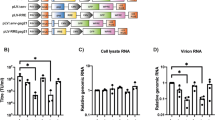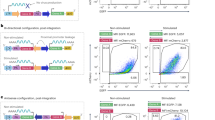Abstract
Site-specific endonucleases can be engineered for custom recognition of any genetic locus and used for gene targeting. Yet, the prolonged expression and accumulation of these nucleases in cells lead to toxic effect. Here we describe an efficient and quantitative method for introducing nucleases into cells as proteins packaged within lentiviral vector particles. I-CreI-derived meganucleases, which can be engineered as single-chain proteins, were incorporated into lentiviral vector particles either without modification or as fusions with cyclophilin A. The small amount of nuclease delivered by the viral particles is sufficient to induce efficient targeted mutagenesis in human HEK293H and primary T cells. When a repair template sequence was packaged in the lentiviral vector, high levels of homologous gene targeting were obtained and toxicity was markedly reduced.
This is a preview of subscription content, access via your institution
Access options
Subscribe to this journal
Receive 12 print issues and online access
$259.00 per year
only $21.58 per issue
Buy this article
- Purchase on Springer Link
- Instant access to full article PDF
Prices may be subject to local taxes which are calculated during checkout




Similar content being viewed by others
References
Chapman JR, Taylor MR, Boulton SJ . Playing the end game: DNA double-strand break repair pathway choice. Mol Cell 2012; 47: 497–510.
Gaj T, Gersbach CA, Barbas CF III . ZFN, TALEN, and CRISPR/Cas-based methods for genome engineering. Trends Biotechnol 2013; 31: 397–405.
Stoddard BL . Homing endonucleases: from microbial genetic invaders to reagents for targeted DNA modification. Structure 2011; 19: 7–15.
Daboussi F, Zaslavskiy M, Poirot L, Loperfido M, Gouble A, Guyot V et al. Chromosomal context and epigenetic mechanisms control the efficacy of genome editing by rare-cutting designer endonucleases. Nucleic Acids Res 2012; 40: 6367–6379.
Perez EE, Wang J, Miller JC, Jouvenot Y, Kim KA, Liu O et al. Establishment of HIV-1 resistance in CD4+ T cells by genome editing using zinc-finger nucleases. Nat Biotechnol 2008; 26: 808–816.
Li H, Haurigot V, Doyon Y, Li T, Wong SY, Bhagwat AS et al. In vivo genome editing restores haemostasis in a mouse model of haemophilia. Nature 2011; 475: 217–221.
Maier DA, Brennan AL, Jiang S, Binder-Scholl GK, Lee G, Plesa G et al. Efficient clinical scale gene modification via zinc finger nuclease-targeted disruption of the HIV co-receptor CCR5. Hum Gene Ther 2013; 24: 245–258.
Certo MT, Gwiazda KS, Kuhar R, Sather B, Curinga G, Mandt T et al. Coupling endonucleases with DNA end-processing enzymes to drive gene disruption. Nat Methods 2012; 9: 973–975.
Ding Q, Lee YK, Schaefer EA, Peters DT, Veres A, Kim K et al. A TALEN genome-editing system for generating human stem cell-based disease models. Cell Stem Cell 2013; 12: 238–251.
Fu Y, Foden JA, Khayter C, Maeder ML, Reyon D, Joung JK et al. High-frequency off-target mutagenesis induced by CRISPR-Cas nucleases in human cells. Nat Biotechnol 2013; 31: 822–826.
Gabriel R, Lombardo A, Arens A, Miller JC, Genovese P, Kaeppel C et al. An unbiased genome-wide analysis of zinc-finger nuclease specificity. Nat Biotechnol 2011; 29: 816–823.
Mussolino C, Morbitzer R, Lutge F, Dannemann N, Lahaye T, Cathomen T . A novel TALE nuclease scaffold enables high genome editing activity in combination with low toxicity. Nucleic Acids Res 2011; 39: 9283–9293.
Osborn MJ, Starker CG, McElroy AN, Webber BR, Riddle MJ, Xia L et al. TALEN-based gene correction for Epidermolysis Bullosa. Mol Ther 2013; 21: 1151–1159.
Pattanayak V, Ramirez CL, Joung JK, Liu DR . Revealing off-target cleavage specificities of zinc-finger nucleases by in vitro selection. Nat Methods 2011; 8: 765–870.
Petek LM, Russell DW, Miller DG . Frequent endonuclease cleavage at off-target locations in vivo. Mol Ther 2010; 18: 983–986.
Beurdeley M, Bietz F, Li J, Thomas S, Stoddard T, Juillerat A et al. Compact designer TALENs for efficient genome engineering. Nat Commun 2013; 4: 1762.
McConnell Smith A, Takeuchi R, Pellenz S, Davis L, Maizels N, Monnat RJ Jr et al. Generation of a nicking enzyme that stimulates site-specific gene conversion from the I-AniI LAGLIDADG homing endonuclease. Proc Natl Acad Sci USA 2009; 106: 5099–5104.
Ramirez CL, Certo MT, Mussolino C, Goodwin MJ, Cradick TJ, McCaffrey AP et al. Engineered zinc finger nickases induce homology-directed repair with reduced mutagenic effects. Nucleic Acids Res 2012; 40: 5560–5568.
Bindra RS, Goglia AG, Jasin M, Powell SN . Development of an assay to measure mutagenic non-homologous end-joining repair activity in mammalian cells. Nucleic Acids Res 2013; 41: e115.
Wehrkamp-Richter S, Degroote F, Laffaire JB, Paul W, Perez P, Picard G . Characterisation of a new reporter system allowing high throughput in planta screening for recombination events before and after controlled DNA double strand break induction. Plant Physiol Biochem 2009; 47: 248–255.
Berkovich E, Monnat RJ Jr, Kastan MB . Roles of ATM and NBS1 in chromatin structure modulation and DNA double-strand break repair. Nat Cell Biol 2007; 9: 683–690.
Pruett-Miller SM, Reading DW, Porter SN, Porteus MH . Attenuation of zinc finger nuclease toxicity by small-molecule regulation of protein levels. PLoS Genet 2009; 5: e1000376.
Qasim W, Vink CA, Thrasher AJ . Hybrid lentiviral vectors. Mol Ther 2010; 18: 1263–1267.
Gaj T, Guo J, Kato Y, Sirk SJ, Barbas CF III . Targeted gene knockout by direct delivery of zinc-finger nuclease proteins. Nat Methods 2012; 9: 805–807.
Voelkel C, Galla M, Maetzig T, Warlich E, Kuehle J, Zychlinski D et al. Protein transduction from retroviral Gag precursors. Proc Natl Acad Sci USA 2010; 107: 7805–7810.
Izmiryan A, Basmaciogullari S, Henry A, Paques F, Danos O . Efficient gene targeting mediated by a lentiviral vector-associated meganuclease. Nucleic Acids Res 2011; 39: 7610–7619.
Qi M, Aiken C . Nef enhances HIV-1 infectivity via association with the virus assembly complex. Virology 2008; 373: 287–297.
Schaller T, Ocwieja KE, Rasaiyaah J, Price AJ, Brady TL, Roth SL et al. HIV-1 capsid-cyclophilin interactions determine nuclear import pathway, integration targeting and replication efficiency. PLoS Pathog 2011; 7: e1002439.
Towers GJ, Hatziioannou T, Cowan S, Goff SP, Luban J, Bieniasz PD . Cyclophilin A modulates the sensitivity of HIV-1 to host restriction factors. Nat Med 2003; 9: 1138–1143.
Paxton W, Connor RI, Landau NR . Incorporation of Vpr into human immunodeficiency virus type 1 virions: requirement for the p6 region of gag and mutational analysis. J Virol 1993; 67: 7229–7237.
Silva G, Poirot L, Galetto R, Smith J, Montoya G, Duchateau P et al. Meganucleases and other tools for targeted genome engineering: perspectives and challenges for gene therapy. Curr Gene Therapy 2011; 11: 11–27.
Briggs JA, Simon MN, Gross I, Krausslich HG, Fuller SD, Vogt VM et al. The stoichiometry of Gag protein in HIV-1. Nat Struct Mol Biol 2004; 11: 672–675.
Luban J, Bossolt KL, Franke EK, Kalpana GV, Goff SP . Human immunodeficiency virus type 1 Gag protein binds to cyclophilins A and B. Cell 1993; 73: 1067–1078.
Mangeot PE, Dollet S, Girard M, Ciancia C, Joly S, Peschanski M et al. Protein transfer into human cells by VSV-G-induced nanovesicles. Mol Ther 2011; 19: 1656–1666.
Gamble TR, Vajdos FF, Yoo S, Worthylake DK, Houseweart M, Sundquist WI et al. Crystal structure of human cyclophilin A bound to the amino-terminal domain of HIV-1 capsid. Cell 1996; 87: 1285–1294.
Branchini BR, Ablamsky DM, Murtiashaw MH, Uzasci L, Fraga H, Southworth TL . Thermostable red and green light-producing firefly luciferase mutants for bioluminescent reporter applications. Anal Biochem 2007; 361: 253–262.
Zufferey R, Dull T, Mandel RJ, Bukovsky A, Quiroz D, Naldini L et al. Self-inactivating lentivirus vector for safe and efficient in vivo gene delivery. J Virol 1998; 72: 9873–9880.
Acknowledgements
We thank A Henry and C Bregnard for technical help and S Basmaciogullari and A Izmiryan for discussions. This work was supported by the French National Research Agency (ANR 2010 BIOT 007 01). Funding for open access charge: French National Research Agency.
Author information
Authors and Affiliations
Corresponding author
Ethics declarations
Competing interests
The authors declare no conflict of interest.
Additional information
Supplementary Information accompanies this paper on Gene Therapy website
Supplementary information
Rights and permissions
About this article
Cite this article
He, C., Gouble, A., Bourdel, A. et al. Lentiviral protein delivery of meganucleases in human cells mediates gene targeting and alleviates toxicity. Gene Ther 21, 759–766 (2014). https://doi.org/10.1038/gt.2014.51
Received:
Revised:
Accepted:
Published:
Issue Date:
DOI: https://doi.org/10.1038/gt.2014.51
This article is cited by
-
‘Hit and run’ therapy averts macular degeneration
Nature Biomedical Engineering (2021)
-
Meganuclease targeting of PCSK9 in macaque liver leads to stable reduction in serum cholesterol
Nature Biotechnology (2018)
-
Improved Cell-Penetrating Zinc-Finger Nuclease Proteins for Precision Genome Engineering
Molecular Therapy - Nucleic Acids (2015)
-
Novel lentiviral vectors with mutated reverse transcriptase for mRNA delivery of TALE nucleases
Scientific Reports (2014)



